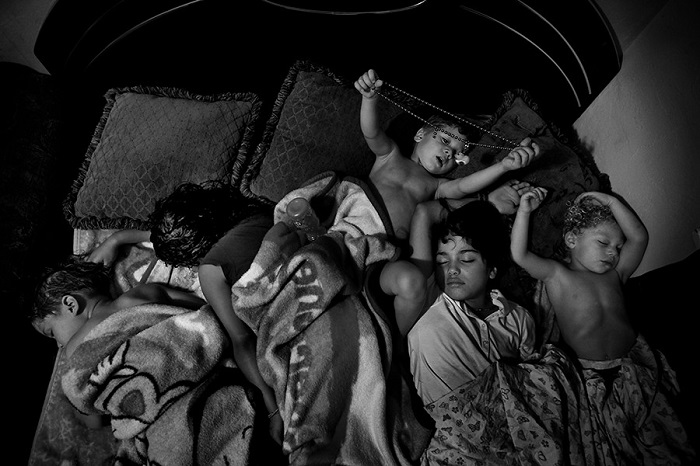Concordia University invited Barbara Davidson to share insights about her life and career
In the words of renowned war photographer Robert Capa: “If your photographs aren’t good enough, then you’re just not close enough.” One thing is certain: Barbara Davidson has gotten close enough to produce emotional photos that evoke empathy. “The most important thing my upbringing taught me is empathy,” Davidson said. “It’s something that one really has to possess in order to be a really good photojournalist or good journalist.”
On Sept. 14, Concordia University invited Davidson to a homecoming keynote panel at the DB Clarke Theatre. Since graduating from Concordia with a bachelor’s degree in fine arts 27 years ago, Davidson has won three Pulitzer prizes, which is the most prestigious award for journalists. Davidson has also earned a national Emmy Award and was twice named newspaper photographer of the year by Pictures of the Year International. “I usually don’t talk about myself in these presentations. I’m usually far more interested in the people that I document,” she said. “Since it’s Montreal and I’m coming home, I thought that it would be nice to give people a perspective of how I ended up living in the United States and covering all the stories that I covered.”
Davidson discussed elements of her career and life as an award-winning photojournalist, and how she paved her way to success with nothing but hard work and perseverance. She was raised by her Irish mother, who worked part-time while taking care of seven children. “My upbringing had a profound influence on the journalist I became,” she said. “It really taught me what it’s like to go without, to live a life that was difficult. It taught me about the human condition from first-hand experience.”
According to Davidson, it was her grandfather, who took pictures of her family, who inspired her passion for photography. “He was the original photographer of the family,” she said. “He had an incredible passion for taking pictures.” When Davidson’s parents left Ireland for Canada in search of a better life, they packed bundles of family photos into their suitcases. “We had this drawer that was full of all these family photos, and I loved them so much,” she said. “Photography really meant something in my family. It was a really special thing.”
Davidson was 15 when she first decided she wanted to become a photographer. “I didn’t really know that I would be this kind of photographer. I didn’t know that my dream would end up here on the front page of the Los Angeles Times,” she said.
Davidson began her career working for one of Concordia’s student newspapers, The Link. “I learned a lot about my craft here at Concordia University, working for the student newspaper. It was incredibly important for me,” she said. “I spent more time on that newspaper than I ever did in class.”
Since then, she has travelled around the world, covering different crises in Afghanistan, Iraq, Israel, Gaza, the Democratic Republic of Congo and the United States. She documented the catastrophe and repercussions of hurricane Katrina and was recently in Texas covering the devastation of hurricane Harvey for the New York Times. “I had been trained as a Red Cross worker before I became a journalist, so I was and still am always interested in the most vulnerable people,” she said.
Davidson has also done a lot of work abroad. “It was like parachute journalism, where I would be dispatched to Iraq and hit the ground and figure out how to navigate,” she said. During the presentation, Davidson showed a video compilation of some of her photos taken abroad. The rawness of the photos demonstrated how close Davidson managed to get to the lives of thousands of different people all around the world. These pictures said more than a thousand words—they showed the strong emotions people experienced in their most vulnerable life situations.
Davidson made it clear that her career did not come easily. It has taken her a long time to get to this point, and she discussed how rejection was part of her journey. “I [used] my rejection to fuel my desire to make it because this craft of photojournalism is so competitive and it’s so difficult so that rejection could have made me fall into a corner and have me cry a lot—but it just made me angry and it made me want it even more,” she said. “It made me say, ‘I’ll show you.’”
Davidson also explained that it isn’t necessary to travel overseas to document death and destruction—it can happen right in your backyard. When Davidson moved to Los Angeles, she said she noticed that many people were desensitized to violence. In nearby low-income neighbourhoods, people were experiencing a high level of gang violence. She decided it was her time to tell a substantive story about the victims of gang violence.
As part of her talk, she showed a short film which introduced the audience to the families she ended up spending a lot of time with for this project. “I always paid attention to people caught in the crossfire, the innocent victims who really had nothing to do with conflict but were caught in it,” Davidson said. When she initially approached her editors at the Los Angeles Times with her story idea, the newspaper rejected it. Davidson ended up working on the story for about six months on her own before she was given the green light to have her work published in the newspaper.
Davidson told the audience loud and clear: “You can study to be a journalist, which is a wonderful thing, but if you don’t have it inside of you to really be a journalist, you’re not going to be a journalist. It’s something a lot more than just learning trade—it’s a way of life. It’s not just a job for me.”
Main photo by Barbara Davidson in her feature on gang violence for the Los Angeles Times
